b) 3D molecular structures
(i) Types of structure file
One of the most impressive ways to make an electronic presentation more visually appealling is to include the 3D structure files of the molecules you are discussing. The minimum would be to simply have a colour gif image of the 3D structure, but it is far more spectacular if you can include the entire data for the 3D structure, displayed in a way that can be manipulated by the reader, in an interactive fashion. But before you can begin, you will need to obtain the 3D structure file for your molecule. There are at least 20 different formats for storing the structural details of a molecule, and these have varying degrees of detail. Some formats only store the x,y,z coordinates of the atom positions, but some store far more information as well, such as (i) the details of which atoms are bonded to which, (ii) whether those bonds are single, double, triple or aromatic, (iii) if any of the atoms or groups are charged, (iv) the possibilities of hydrogen bonding, (v) molecular oribital information, and so on. A program called Babel can be used to convert between most of these formats. Luckily, of all these formats, only four are widely used on the internet.
- pdb - protein databank files are usually quite compact and are often used for storing structural data for large molecules, such as proteins. However they do not store bond order information, and so the presence of double or triple bonds is not displayed.
- xyz file - this format contains only the x,y,z atomic coordinate information. This format is useful for making animations of chemical processes, such as bond breaking/making, or vibrations (see later).
- mol - one of the most popular formats is the 'molfile', which contains a lot of structural information about the molecule, including which atoms are bonded to which, and the bond order.
- wrl - VRML (virtual reality markup language) 'world' files are also quite common, since they show the full structural information, and with the choice of a suitable VRML viewer can give very good interactivity. Unlike the other formats, however, this is not specifically a chemical exchange format, but an internet standard for many different types of 3D scenes. But it works very well for 3D chemical information, although because of the amount of information stored about the molecule, the file sizes can be inordinately large compared to the other filetypes.
Examples of the content of 3 of these file formats for the toluene molecule can be seen in Appendix 1. The VRML file is too large to display in text form in this article, but it can be viewed by downloading it from here and loading it into a text package such as Windows Notepad.
(ii) Databases of 3D structure files
So how do you get hold of these structure files? Well, there are now quite a number of free databases on the internet which contain the structure files for most common molecules. Simply go to one of these sites and download the files. Since the files contain only the structural information about a molecule, there are no copyright issues to worry about, although it is usually polite to cite the database from where you obtained your structure. Three of the most user-friendly databases are given below, but remember that this isn't all there is - simply searching for a molecular structure, such as "toluene.mol" on a search engine like Alta Vista [1] will give any available instances of it on the web.
- Webmolecules [2] is an excellent database containing over 220,000 structures for common molecules in mol and VRML formats, and can be searched by name, chemical formula, CAS number, etc. If the structure you require is not on their database, you can even request them to make it for you!
- Another useful database is The Virtual Museum of Minerals and Molecules [3].
- The Protein Databank [4] contains almost 15,000 structures for large proteins, such as DNA fragments, all in pdb format.
- NCI database [5] has over 250,000 3D structures, which include 3D coordinates of up to 25 conformers of these structures.
- Cambridge Crystallographic Data Centre [17] is a computerised database containing comprehensive 3D structure data for organic and metal-organic compounds.
(iii) Making your own 3D structure files
But what happens if the molecule you wish to display is not in any of the databases? In that case, you'll have to construct it yourself. This sounds daunting, but with modern software packages it's actually very easy. Most readers will be familiar with chemical drawing packages which make drawing 2D structures simple. Common packages include ChemDraw and ChemDraw 3D, IsisDraw and Chemweb. Some of these packages now offer the option to save your 2D drawing into a 3D format, usually mol, pdb or wrl. The packages optimise the configuration for minimum energy, and some even know the valency rules for each element. This allows hydrogens to be added in the correct places and with the correct orientation, without having to draw each one in specifically, which could be a laborious process for a large molecule.
Another extremely useful package, which is free, is MSI's WebLab Viewer. This package can be used to draw and edit structure files in 3D, as well as clean up errors in files created by other packages. The following images show how WebLab viewer can import a molfile of benzene, then one of the hydrogens is selected and changed into a carbon. The package automatically adds the correct number of hydrogens around the new carbon, in the correct orientation to create toluene. This sidegroup is then selected and moved to a new (chemically unrealistic) position by stretching and twisting the bond.
Fig.4. Editing a molecular structure in 3D using WebLab viewer.
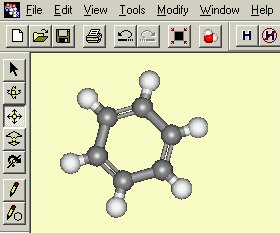
(a) The imported molfile for benzene. | 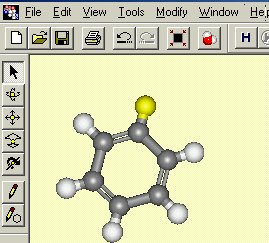
(b) One of the H's is selected and highlighted in yellow. |
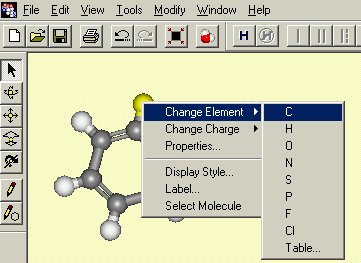
(c) By right-clicking on the selected element, it can be changed into another, in this case into a C. | 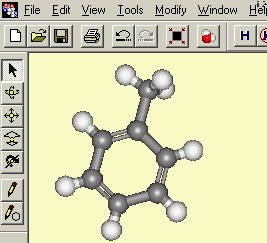
(d) The C is created, and the software automatically adds 3 H's in the correct orientation. |
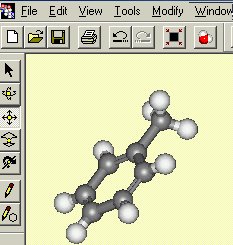
(e) The molecule is rotated into a new orientation. | 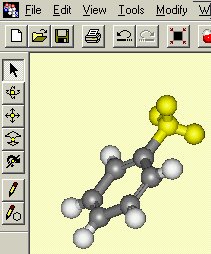
(f) The new methyl group is highlighted. |
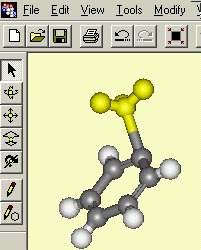
(g) The group is then moved to a new position, stretching the bond. | 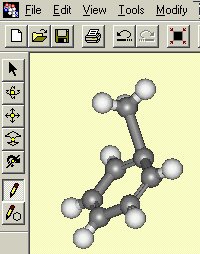
(h) The finished structure. This is a chemically unrealistic structure, but it illustrates how molecular structures can be edited in 3D. |
Other packages can also be used to edit molecular structures in 3D in a similar fashion, such as ChemDraw 3d and Molecules-3d. For VRML structures, there is an online service at the University of Erlangen called 'VRML File Creator for Chemical Structures' [10] which allows the generation of VRML scenes from 2D or 3D data files. It supports over 40 structure file formats and also contains a molecule editor for online structure input. 3D crystal structures in VRML format can be generated using an online service or downloadable program from the Institut Laue-Langevin in France, called xtal-3d [18].
Next Page - Displaying 3D Structures







